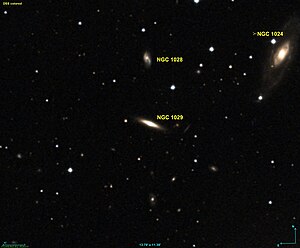NGC 1029
| Galaxy NGC 1029 |
|
|---|---|

|
|
| AladinLite | |
| Constellation | Aries |
|
Position equinox : J2000.0 , epoch : J2000.0 |
|
| Right ascension | 02 h 39 m 36.5 s |
| declination | + 10 ° 47 ′ 36 ″ |
| Appearance | |
| Morphological type | S0 / a |
| Brightness (visual) | 13.2 mag |
| Brightness (B-band) | 14.1 mag |
| Angular expansion | 1.4 ′ × 0.4 ′ |
| Position angle | 70 ° |
| Surface brightness | 12.5 mag / arcmin² |
| Physical data | |
| Affiliation | LGG 69 |
| Redshift | 0.012125 ± 0.000060 |
| Radial velocity | 3635 ± 18 km / s |
|
Stroke distance v rad / H 0 |
(164 ± 11) · 10 6 ly (50.4 ± 3.5) Mpc |
| history | |
| discovery | Albert Marth |
| Discovery date | October 1, 1864 |
| Catalog names | |
| NGC 1029 • UGC 2149 • PGC 10078 • CGCG 439-024 • MCG + 02-07-024 • 2MASX J02393654 + 1047361 • GALEX ASC J023936.57 + 104737.5 • LDCE 180 NED003 | |
NGC 1029 is a lenticular galaxy of the Hubble type S0 / a in the constellation Aries north of the ecliptic . It is an estimated 164 million light years away from the Milky Way and has a diameter of about 65,000 ly. Together with NGC 990 and NGC 1012 , it forms the small NGC 1012 group ( LGG 69 ).
In the same area of the sky are u. a. the galaxies NGC 1024 and NGC 1028 .
The object was discovered by Albert Marth on October 1, 1864 .
